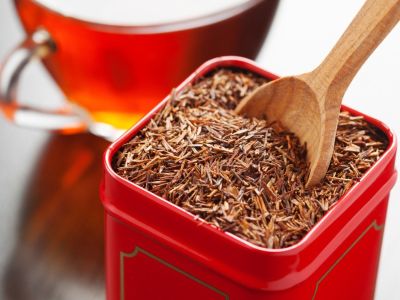The Rooibos Tea Plant
Unlike most other types of herbal teas, rooibos is not a blend of plants, fruit and spices. Instead, it is created by carefully fermenting and drying the leaves of Aspalathus linearis. This shrub is native to Africa, where it can be found growing on sandy hills and the sides of mountains. Rooibos tea was traditionally used by the indigenous people of Southern Africa, but has been cultivated for commercial sale within the last 100 years. Grown on farms in its native range, the rooibos plant is a very hardy crop which can withstand periods of drought. Although Aspalathus linearis is a perennial, southern African plantations only harvest leaves from these shrubs for about four to seven years. After which, the plants are removed, the land is burned and the field is rotated with another crop. This organic method of farming allows other crops to utilize the nitrogen in the soil from rooibos crops. It also aids in the control of leafhoppers and diseases which can greatly reduce rooibus leaf production.
Growing Aspalathus linearis at Home
Rooibos growing conditions include full sun and well-drained sandy soil which has moisture-retaining capabilities. This shrub can reach a maximum height of about 6.5 feet (2 m.) and it has the ability to fix nitrogen. In the United States, the hardiness of rooibos ranges from zones 8 to 11, but it can be grown in containers elsewhere. Propagation of the rooibos tea plant is by seed or vegetative means. This hermaphrodite species produces yellow flowers in spring to mid-summer. These are followed by small, lance-shaped pods containing one or two seeds. Seeds require scarification and soaking, before sowing in an acidic sand mixture. Rooibos plants require protection from winter elements as well as wet conditions. Growing young plants indoors or in a greenhouse for their first winter is recommended. Additionally, home gardeners may find it takes a year or more before a rooibos plant produces a harvestable quantity of leaves.
Harvesting the Rooibos Leaf for Tea
In its native lands, the rooibos leaf is harvested one time per year. After cutting young branches by hand, the stems and leaves are bundled for ease of transport to a processing center. Here, the rooibos is chopped, piled in rows and allowed to ferment overnight. Enzymatic oxidation changes the green Rooibos plant material to the shade of reddish amber which gives this tea its characteristic color. The tea is then dried naturally by spreading the fermented plant material out in the sun. The entire process takes less than 24 hours. After drying, the tea is graded before being packaged for commercial distribution.
